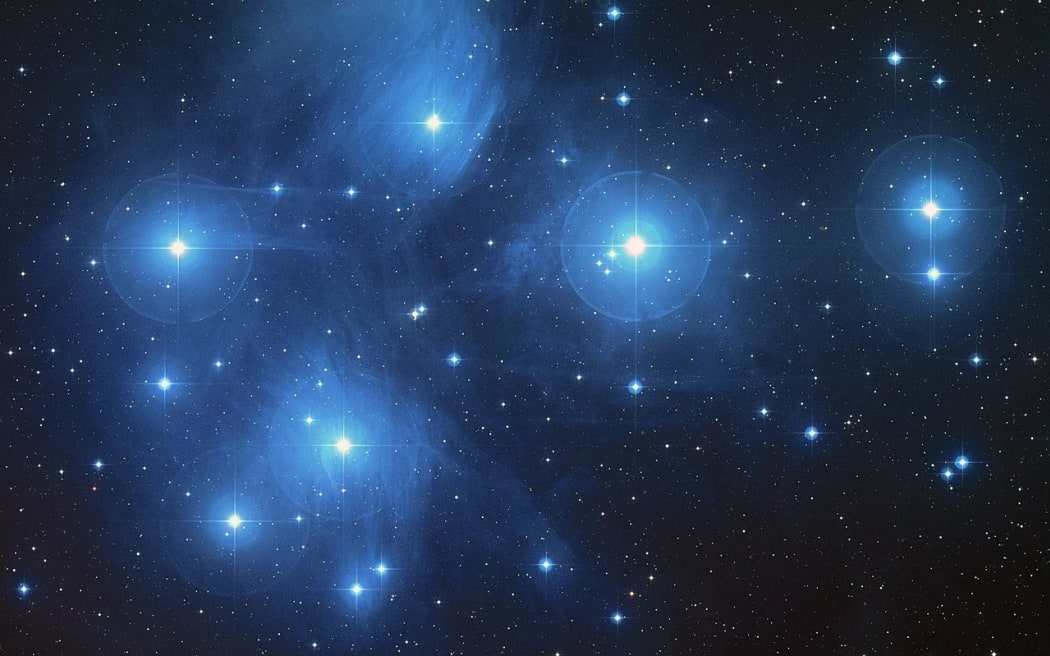The myths around the Matariki constellation in Aotearoa are essentially the same as every other Pleiades tale anywhere – which could make it the world's oldest story.

Matariki will be celebrated as a national public holiday for the second time in New Zealand's history on Friday 14 July 2023. Photo: Public Domain, ex NASA
In Japan, it is called Subaru. Not a car, but the name of a star cluster.
In India, it is Krittika. Here in Aotearoa, it is Matariki.
They are all versions of the Pleiades – or Seven Sisters myth about seven young girls being chased by a man associated with the Orion constellation.
Matariki is short for Ngā Mata o te Ariki Tāwhirimātea – the eyes of Tāwhirimātea, the god of the wind. He was so angry when his siblings separated their parents Ranginui the sky father and Papatūānuku the earth mother that he tore out his eyes and threw them into the heavens. Some iwi say there are nine stars, others say seven, but the story behind it is the same.
In Greek stories, the Pleiades are the seven daughters of the titan Atlas who were pursued by the hunter Orion.
In some Aboriginal cultures, it is about seven sisters running away from the Jampijinpa man. He follows them into the sky, travelling as a star in the Orion's Belt cluster.
The story is so similar in vastly different cultures that it has inspired astrophysicist Ray Norris to explore whether it could be our oldest, perhaps originating in Africa 100,000 years ago.
"I grew up in England but I've spent most of my life in Australia," Norris tells The Detail from his home in Sydney.
"In England I was fascinated by things like Stonehenge and the Bronze Age Circles – clearly people doing astronomy. And when I moved to Australia it was natural to ask, do the Aboriginal people do anything similar?
"There were lots of songs and stories of the sky, that was very well known. What wasn't clear was whether the Aboriginal people really tried to understand what was going on in the sky, why eclipses happened or what makes the tides move, why the planets move as they do.
"Spoiler alert: yes, absolutely."
Norris has written a book about Aboriginal Astronomy, highlighting the depth and complexity of their knowledge of the sky, and says their Seven Sisters story is uncannily similar to the ancient Greek myth despite there being no cultural connection between them and the Europeans until Australia was invaded by the British.
Without the cultural contact, is the story coincidence, or do they have a common origin?
"We all came out of Africa around 100,000 years ago. Is it possible that story could be that old?"
Tentatively yes, says Norris, pointing to stories around the world which share the same theme, not just about the seven sisters being pursued by the hunter from Orion, but explanations about why there are only six bright stars. In Islam, for example, one of the sisters fell to earth; in some Aboriginal cultures one of the sisters is ashamed and hiding behind a bush.
As part of his continuing research, Norris wants to follow some of the paths of human migration and see how the story evolves over geography.
The blue-tinged Pleiades are relatively young group of stars, formed about 100 million years ago. They have wisps of gas around them which enhance their beauty, says Norris, and may explain why they are called girls or women.
Find out more about the various versions of Matariki myths around the world by listening to the full podcast.
Check out how to listen to and follow The Detail here.
You can also stay up-to-date by liking us on Facebook or following us on Twitter.

Photo:


